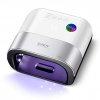B
BLUE
Member
Full Member
- Messages
- 92
- Reaction score
- 1
Hello,
Can anyone tell me the result of Gc Optiglaze on the dentures?
Does it really last long time? some people said that it will be come off within couple of days or something.
If anyone used it before on the dentures please let me know.
Also is it work if i layer it after the polish? or is it better to use it after sandblast the denture?
Thank you
Can anyone tell me the result of Gc Optiglaze on the dentures?
Does it really last long time? some people said that it will be come off within couple of days or something.
If anyone used it before on the dentures please let me know.
Also is it work if i layer it after the polish? or is it better to use it after sandblast the denture?
Thank you


